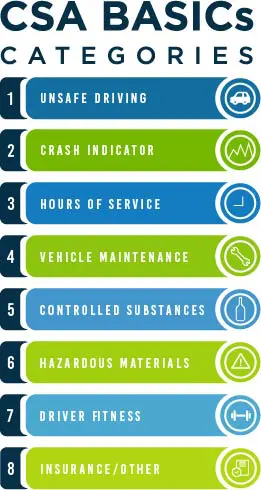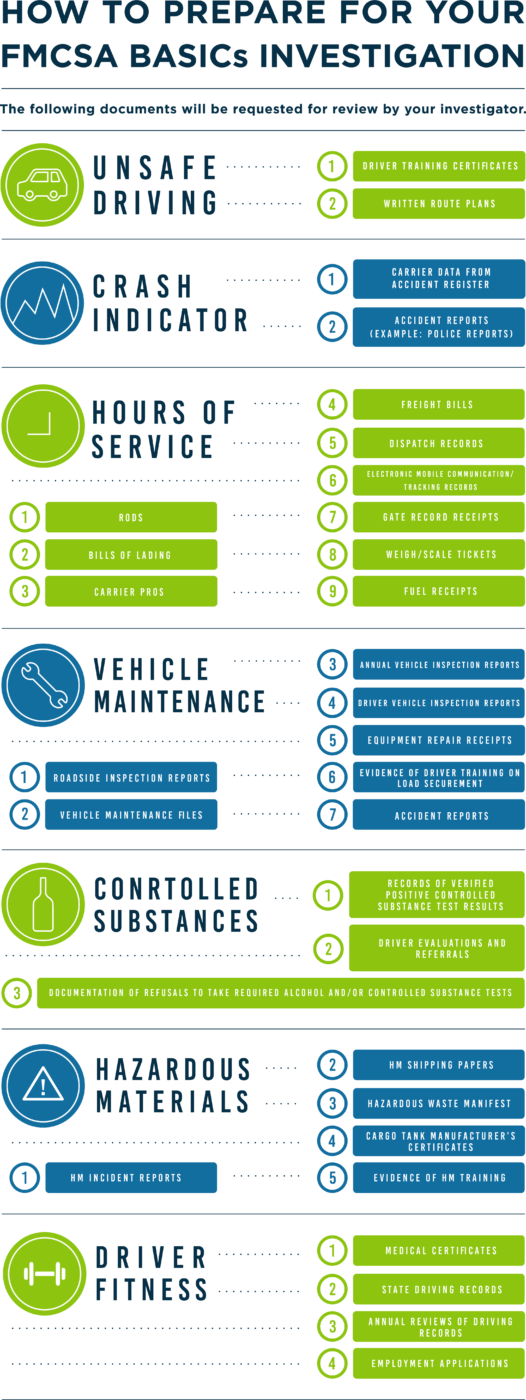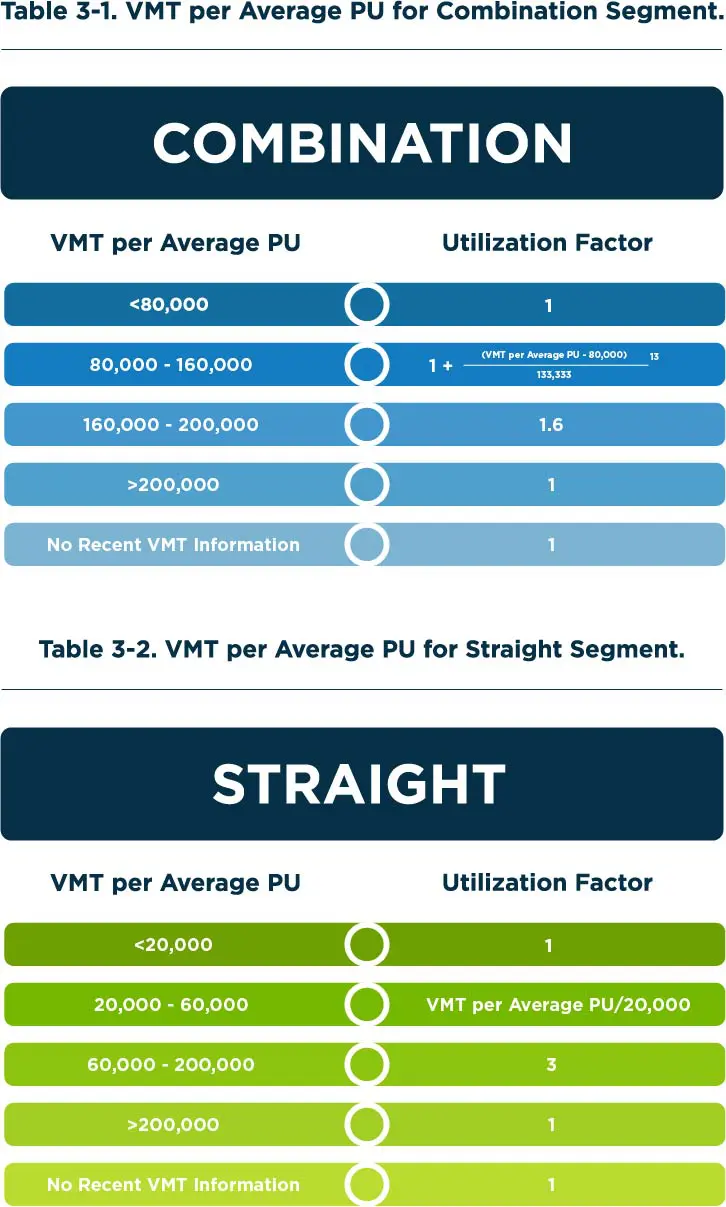The Behavioral Analysis and Safety Improvement Categories (BASICs) are seven different measurement groups that the CSA uses to monitor the overall safety compliance for motor carriers. Crash indicator, Hazardous Materials, and Insurance related BASICs are not available to the public.
Considering the documents provided online to guide you through each of the BASICs are quite extensive, we put a simplified version together to help motor carriers quickly understand what is required for compliance and what you can do to prepare for an upcoming investigation.
In this document you will learn:
- What is the CSA?
- What is SMS?
- What is the method used to measure compliance?
- What are the 7 BASICs?
- What do I do if I receive a warning letter from FMCSA?
- How can I remove a warning on my record?
- What happens if I am being investigated by the FMCSA?
- What documents will I need on hand for my investigation?
- What is considered a bad CSA score?
- Where do I find my current CSA score?
- How are CSA scores calculated?
WHAT IS CSA?
CSA stands for Compliance, Safety, and Accountability. It is a safety program that the Federal Motor Carrier Safety Administration (FMCSA) put in place to make sure motor carriers and owner-operators are held accountable for all different safety requirements.
WHAT IS SMS?
The Safety Measurement System (SMS) is the method of which the CSA uses to measure each individual BASIC category.
THE SMS USES THE FOLLOWING METHODS FOR MEASURING COMPLIANCE
- The number of safety violations and inspections: The more you have in the past 24 months, the higher the chance of being investigated. More recent events weigh heavier than later events.
- The severity of safety violations or crashes: Fatalities or crashes involving the release of hazardous materials weigh heavier than simple fender benders.
- When the safety violations occurred: Recent events weigh heavier with 24 months being the max.
- Vehicle amount owned in conjunction with miles travelled: this is used to compare similar owner operators and find industry averages to improve data comparison.
- Acute and Critical Violations found during investigations: whether it was a one-time violation (Acute) or multiple violations (Critical)

WHAT ARE THE DIFFERENT BASIC CATEGORIES?
Unsafe Driving
- Texting
- Speeding
- Using a Hand-Held Cell Phone
- Reckless Driving
- Improper Lane Change
- Inattention
- Not wearing a safety belt
- SOURCE: https://csa.fmcsa.dot.gov/Documents/FMC_CSA_12_008_BASICs_UnsafeDriving.pdf
Crash Indicator (Not Public)
- Crash history and involvement
- SOURCE: https://csa.fmcsa.dot.gov/Documents/FMC_CSA_12_005_BASICs_Crash_Indicator.pdf
Hours of service compliance (HOS)
- Alertness
- Responsiveness
- Time off between trips
- Knowledge of ELD or AOBRD
- Paper Logs (if applicable)
- SOURCE: https://www.fmcsa.dot.gov/regulations/hours-service/summary-hours-service-regulations
Vehicle Maintenance
- Pre-trip and Post-trip inspections
- Vehicle Defects
- Repairs
- SOURCE: https://csa.fmcsa.dot.gov/Documents/FMC_CSA_12_009_BASICs_VehMaint.pdf
Controlled Substances/Alcohol
- Impairing driving abilities
- Prescription medication
- Alcohol
- Illegal drugs
- SOURCE: https://csa.fmcsa.dot.gov/documents/fmc_csa_12_022_sub_alc_smc.pdf
Hazardous Materials (HM) Compliance (Not Public)
- Properly packaged materials
- Mark/Label/Placard/Load HM
- Knowledge of regulations
- SOURCE: https://csa.fmcsa.dot.gov/Documents/FMC_CSA_13_001_BASICs_HM_Compliance.pdf
Driver Fitness
- Invalid license
- Medically unfit to operate a CMV
- Medical Certificates
- State Driving Records
- Annual reviews
- Employment Applications
- SOURCE: https://csa.fmcsa.dot.gov/Documents/FMC_CSA_12_006_BASICs_DriverFitness.pdf
It should be noted that Insurance/Other indicator is technically the 8th BASIC, but it is only measured in a non-public manner and enforced during traffic stops as well as during inspections/investigations.
WHAT DO I DO IF I RECEIVE A WARNING LETTER FROM THE FMCSA?
The first step the FMCSA takes in recognizing that you are not in compliance with one or more of the BASIC guidelines is by sending you a warning letter. If you are keeping track of your SMS data online at http://ai.fmcsa.dot.gov/sms/ then the warning letter should be of no surprise to you. The CSA will mark your data with a (Triangle) indicator and give you specific details online for you to make corrections. Warning letters are sent out by mail to make sure all motor carriers are aware of the non-compliance issues as well as the consequences of not improving. Depending on the severity of the compliance issue, your warning letter may include an Onsite or Offsite investigation.
STEP ONE
- Remain calm, just because you received a letter of non-compliance does not necessarily mean you are in serious trouble. With multiple moving pieces in a fleet managers day to day, it can be easy to simply overlook an issue that needs addressing. This is one of the reasons the CSA was created. Use it as an added benefit to keep your drivers and others on the road safe from harm’s way.
STEP TWO
- Log in to the SMS to read about the details of your non-compliance, there will be corrective actions taken if the warning is ignored and you should treat it as a top priority to prevent an investigation. Discover and research your specific warning and start thinking about the actions that are in your control to make changes.
STEP THREE
- Use the provided Safety Management Cycle (SMC) as a methodology to help you make the necessary changes pertaining to your non-compliance. Gather as much information and data as you can to prove to the FMCSA that you fixed the issue. Each individual BASIC has a SMC specifically for that BASIC. The SMC is a great practice for all motor carriers to implement in their organization.
STEP FOUR
- Once you believe that you made the necessary changes to fix your safety compliance issues, only a new investigation/intervention from the FMCSA will help lower your percentile rank in that specific BASIC
HOW CAN I REMOVE A WARNING ON MY RECORD?
If you feel that your data is incorrect on the SMS, then you can Request a Data Review (RDR) through the DataQ system available to all motor carriers. The FMCSA will submit your request and make changes if the data is found to be incorrect. You can also read more about the process of the DataQs system with the following fact sheet: https://dataqs.fmcsa.dot.gov/Data/Factsheets/DataQs_Factsheet.pdf
WHAT HAPPENS IF I AM BEING INVESTIGATED BY THE FMCSA?
The FMCSA will conduct investigations on motor carriers who are non-compliant with the CSA guidelines. Investigations are usually conducted when an acute or critical violation is shown as a heavily weighted incident or a pattern of non-compliance. Investigations can also be the result of ignoring compliance issues and/or warning letters.
In the event that you are notified of an upcoming investigation, we put together a list of documents you will need to have on hand to prepare. Your Safety Investigator (SI) may request additional information or documents.

DOCUMENTS REQUIRED FOR YOUR FMCSA INVESTIGATION
UNSAFE DRIVING:
- Driver Training Certificates
- Written Route Plans
CRASH INDICATOR:
- Carrier data from accident register
- Accident reports
HOURS OF SERVICE
- Freight bills
- RODS
- Bills of lading
- Carrier pros
- Dispatch records
- Electronic mobile communication/tracking records
- Gate record receipts
- Weigh/Scale tickets
- Fuel receipts
VEHICLE MAINTENANCE:
- Roadside inspection reports
- Vehicle maintenance files
- Annual vehicle inspection reports
- Driver vehicle inspection reports
- Equipment repair receipts
- Evidence of driver training on load securement
- Accident reports
CONTROLLED SUBSTANCES:
- Records of verified positive controlled substance test results
- Driver evaluations and referrals
- Documentation of refusals to take required alcohol and/or controlled substance tests.
HAZARDOUS MATERIALS:
- HM incident reports
- HM shipping papers
- Hazardous waste manifest
- Cargo tank manufacturer’s certificates
- Evidence of HM training
DRIVER FITNESS:
- Medical certificates
- State driving records
- Annual reviews of driving records
- Employment application
If you are flagged for an investigation, depending on the severity, one of three different types of investigations can occur.
- Offsite: Safety investigators handle everything remotely by going over documents submitted from motor carriers and data collected from the SMS. Usually an offsite investigation occurs when the violation is minor and no further information is needed from in-person interviews.
- Onsite Focused: Safety investigators travel to your location to handle in-person interviews with employees, document collection and review, as well as random vehicle inspections. Usually this type is focused on the specific violation that caused the investigation to occur.
- Onsite Comprehensive: Safety investigators dissect your entire operation, not just the non-compliance that brought them to your place of business. Interviews with employees, vehicle inspections, as well as your overall safety operation will be placed under review. Usually this type is caused from severe acute or critical violations and a history of non-compliance is apparent.
Warning: Failure to fix non-compliance issues can lead to fines and suspension/cancellation of your entire operations.
WHAT IS CONSIDERED A BAD CSA SCORE?
The FMCSA uses multiple different data sources retrieved from the SMS to rank owner operators by percentile. These percentages are used as thresholds or “ceilings” that if an organization goes above them, then intervention is necessary. More detail of how the thresholds are obtained further down in this document.
Each threshold is broken down into three categories, General, Hazardous Materials, or Passenger Carrier. Most carriers will fall under the “general” threshold unless they meet the requirements of a passenger carrier or a hazardous materials carrier.

General Carriers CSA Intervention Threshold
- Unsafe Driving: Greater than 65%
- Crash Indicator: Greater than 65%
- HOS Compliance: Greater than 65%
- Vehicle Maintenance: Greater than 80%
- Controlled Substances: Greater than 80%
- Driver Fitness: Greater than 80%
- Hazardous Materials: Greater than 80%
Passenger Carrier’s CSA Intervention Threshold
- Unsafe Driving: Greater than 50%
- Crash Indicator: Greater than 50%
- HOS Compliance: Greater than 50%
- Vehicle Maintenance: Greater than 65%
- Controlled Substances: Greater than 65%
- Driver Fitness: Greater than 65%
- Hazardous Materials: Greater than 80%
Hazardous Materials CSA Intervention Threshold
- Unsafe Driving: Greater than 60%
- Crash Indicator: Greater than 60%
- HOS Compliance: Greater than 60%
- Vehicle Maintenance: Greater than 75%
- Controlled Substances: Greater than 75%
- Driver Fitness: Greater than 75%
- Hazardous Materials: Greater than 80%
WHERE DO I FIND MY CURRENT CSA SCORE?
It is advised by the FMCSA that you should be checking your overall data at least once a month to stay informed on where your organization stands under the CSA guidelines. You can log in with your U.S. DOT Number to check all non-public data pertaining to your operation. Log in to your SMS by clicking here https://ai.fmcsa.dot.gov/Login/Default.aspx?ReturnURL=/sms/
HOW DOES THE FMCSA CALCULATE CSA SCORES?
Percentile ranks are given as scores for each of the 7 BASICs. The higher the percentile rank (as indicated above) the more likely chance of a FMCSA intervention. Considering motor carriers have multiple different types of Power Units (PU) as well as Vehicle Miles Travelled (VMT), the FMCSA takes this into consideration when collecting the data from the SMS. Carriers are segmented into similar groups and then rated accordingly to prevent skewed data. For example, A fleet of school buses will not be segmented and rated in comparison to a fleet of HM carriers.
CALCULATING BASICs PERCENTILES
TIME WEIGHT
- Within the last 6 months = 3
- 6 to 12 months = 2
- Older than 12 months = 1
SEVERITY WEIGHT
Violation severity weights can be found on the SMS methodology Document online. Download it to see page numbers in the pdf document.
- Unsafe Driving Severity Weight Data: Page 49, Table A-1
- HOS Compliance Severity Weight Data: Page 54,Table A-3
- Vehicle Maintenance Severity Weight Data: Page 68, Table A-5
- Controlled Substance Severity Weight Data: Page 104, Table A-7
- Hazardous Materials Severity Weight Data: Page 109, Table A-9
- Driver Fitness Severity Weight Data: Page 145, Table A-11
AVERAGE POWER UNITS (PU)
Average PU = (PU Current) + (PU 6 Months) + (PU 18 Months) / 3
UTILIZATION FACTOR
Adjusts the average Power Units values based on how they are utilized in terms of Vehicle Miles Travelled (VMT) in the past 24 months. VMT data used is primarily from form MCS-150 and MCS-151 (filled out by law enforcement)
SEGMENTS
Carriers are placed into two different segments to properly compare with industry averages of similar carriers.
Combination: Combination trucks or motor coach buses constituting 70% or more of the total PU
Straight: Straight trucks or other vehicles constituting more than 30% of the total PU

Unsafe Driving BASIC for Combination and Straight segments: Page 25, Table 3-3, 3-4.
Crash Indicator BASIC for Combination and Straight segments: Page 29, Table 3-9, 3-10
RELEVANT INSPECTION PERCENTAGE GROUPS
Used to compare similar data from similar segments in order to properly rank carriers on a percentile basis. After calculating each BASIC, the result is compared using these charts with similar carriers in your industry to decide where you should rank. Remember that the higher your percentage, the higher chance of intervention (with the threshold cap guaranteeing an intervention from the FMCSA.).
Each individual BASIC has different methods for ranking by relevant inspections. Here is a quick guide to locating the different relevant inspection groups in the SMS Methodology document
HOS Compliance BASIC for Relevant Inspections: Page 32, Table 3-12
Vehicle Maintenance BASIC for Relevant Inspections: Page 35, Table 3-14
Controlled Substances BASIC for Relevant Inspections: Page 37, Table 3-16
Hazardous Materials Compliance BASIC for Relevant Inspections: Page 40, Table 3-18
Driver Fitness BASIC for Relevant Inspections: Page 43, Table 3-20
BASICs FORMULAS
Unsafe Driving BASIC Calculation = (Time Weight x Severity Weight)/(Average PUs X Utilization Factor)
Crash Indicator BASIC Calculation = (Time Weight x Severity Weight)/(Average PUs x Utilization Factor)
HOS Compliance BASIC Calculation = (Time Weight x Severity Weight)/(Total Time Weight x Relevant Inspection %)
Vehicle Maintenance BASIC Calculation = (Time Weight x Severity Weight)/(Total Time Weight x Relevant Inspection %)
Controlled Substances BASIC Calculation = (Time Weight x Severity Weight)/(Total Time Weight x Relevant Inspection %)
HM Compliance BASIC Calculation = (Time Weight x Severity Weight)/(Total Time Weight x Relevant Inspection %)
Driver Fitness BASIC Calculation = (Time Weight x Severity Weight)/(Total Time Weight x Relevant Inspection %)
It should be noted that all of the above data was pulled from https://csa.fmcsa.dot.gov/. We recommend that every motor carrier who has questions or concerns about any of the details of SMS or its methodology, should contact the FMCSA directly. You should also read all of the contents to better understand how to properly stay within the FMCSA guidelines. This document is simply to be used as a summary and overview to quickly identify locations of certain details inside the SMS methodology PDF available online.
Encore Protection provides 24/7 commercial roadside protection 365 days a year. If you feel you are paying too much for fleet roadside assistance, then give us a call and allow us to help save you money and increase your coverage options per vehicle. Call us at 1-844-6ENCORE

Comments are closed